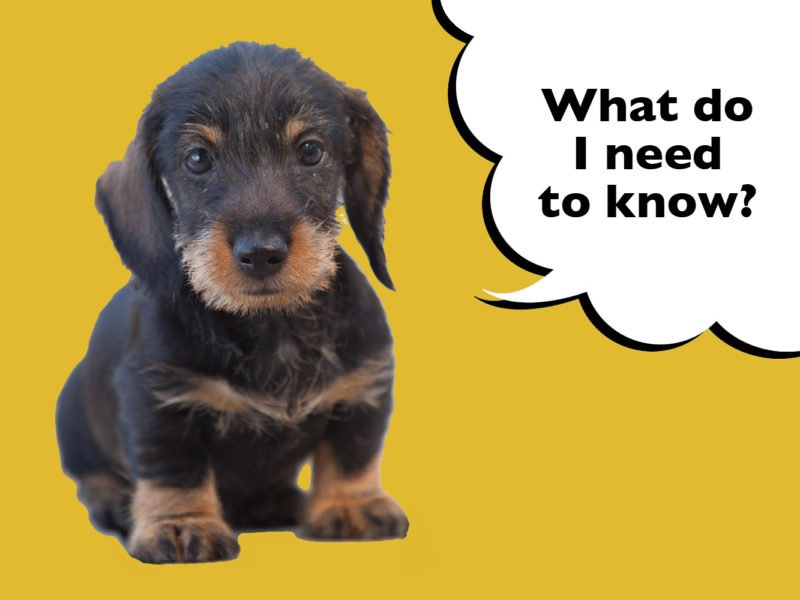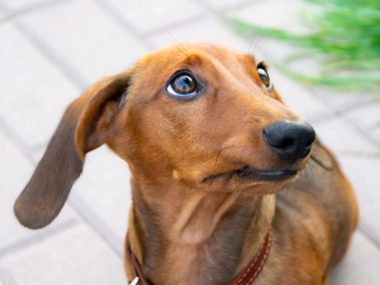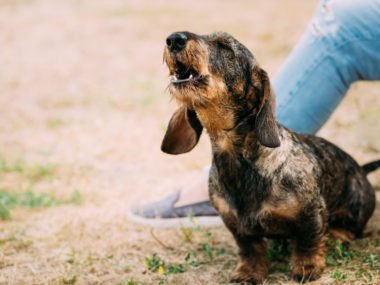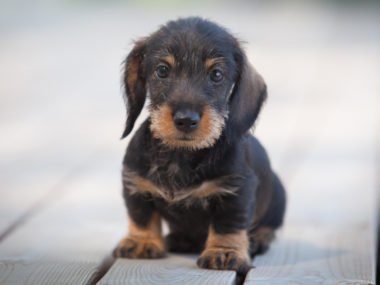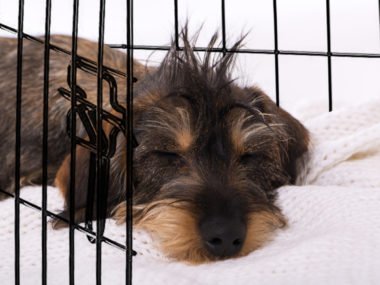Do you have new Dachshund puppy? Are you wondering where to start with dog training? Do you need to know exactly what to do? Here’s 12 things you need to teach your new Dachshund puppy from the first day they come home.
What Do You Need To Teach Your New Dachshund Puppy?
- What their name is
- Where you want them to potty
- Not to be afraid of the crate
- Biting and mouthing can hurt
- Not to be afraid of dog grooming
- Basic training commands
- New sights, sounds and smells
- How their walking equipment feels
- How to walk on a leash
- To come to you when called
- How to use a dog ramp
- Dog training is fun!
Read on to find out why you need to teach your Dachshund puppy these things, and what exactly you need to do!
This article is based on research and personal experience as a Dachshund owner of 10+ years. I’m not a Vet, qualified dog trainer or dog behaviourist.
12 Things You Need To Teach Your Dachshund Puppy
This is what you need to teach your Dachshund puppy:
1. What Their Name Is
The 1st thing you need to teach your Dachshund puppy is to respond to their new name.
Whatever name you decide to give your Dachshund puppy, you need to introduce it to them right away so they know it’s theirs and start coming to you when called.
This is a great way to bond in the first few days, as this training will stay with your Dachshund for the rest of their lives.
To teach your Dachshund puppy to respond to their name, do some short 5 minute training sessions several times a day.
However, don’t go overboard with lots of different training commands in those first few days. Otherwise it may get too overwhelming or confusing.
Start by using their name somewhere quiet to begin with where your Dachshund is less likely to get distracted. For example, the living room.
Sit on the floor and call your Dachshund’s name while holding a dog treat near to your eyes. If they come over and focus their attention on you, be sure to reward them right away.
Once they’ve got the hang of the basics, you can then try using their name again in a place with more distractions or when there are other people around.
Be sure to say their name clearly each and every time. And don’t confuse it with lots of other words or phrases to get their attention.
Most Dachshunds begin to recognise their name within about 3-5 days, so you shouldn’t have too much trouble with this.
If you haven’t chosen your Dachshund’s name yet, click here to get some inspiration!
2. Where You Want Them To Potty
The 2nd thing you need to teach your Dachshund puppy is where you want them to potty.
Potty training is one of the most essential things you need to teach your Dachshund puppy. And it’s good to start right from the very first day you bring them home.
Your puppy isn’t born with an inbuilt knowledge that they’ve got to go to the toilet outside. This is something you need to teach them.
The potty-training process itself is actually quite simple once you know what you’re doing. However, it can take a lot of time and consistency to fully potty train a Dachshund.
That’s because Dachshunds are notoriously stubborn, which can make potty training more challenging than it is for other dog breeds.
Potty-training is as much about training yourself to recognise the signs that your Dachshund needs to go to the toilet, as it is about training your puppy themselves.
By learning to recognise the signs that your Dachshund is about to go to the toilet, and reacting quickly to them, you can drastically reduce the chances of them having accidents in your home.
Chances are, if your Dachshund puppy does have an accident in the house, it’s more than likely going to be down to their signals being missed by their owners.
After all, your puppy’s bladder is very small and they don’t have the control to hold themselves for long periods. If they’ve got to go, they’ve got to go!
Click here if you need help potty training your Dachshund!
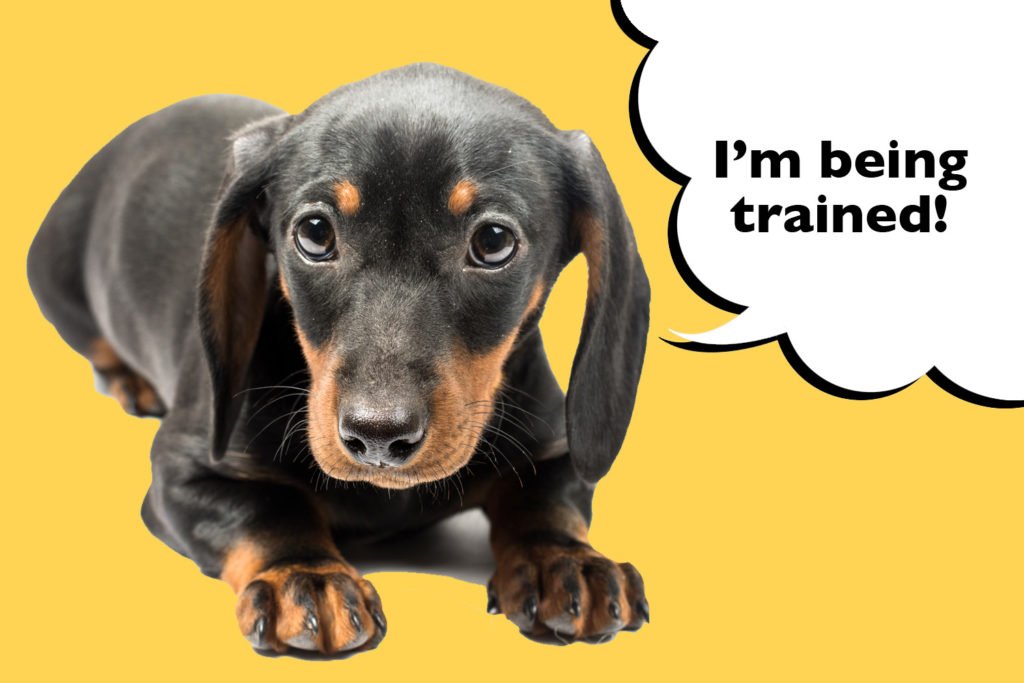
3. Not To Be Afraid Of The Crate
The 3rd thing you need to teach your Dachshund puppy is not to be afraid of the crate.
Although, please note that Crate Training has to be a decision for each individual owner. If it’s not for you and you don’t wish to use a crate, then that’s absolutely fine.
However, crate training can be really useful for a Dachshund. Particularly for assisting with potty training and keeping them safe overnight.
Even if you decide your puppy doesn’t need to use a crate long term, it’s still a good idea to get them to feel comfortable in one.
It’s likely they’ll need to be in one at some point in their lives. Groomers, dog walkers and vets all regularly use crates to secure the dogs in their care.
So by making sure your Dachshund is already used to being in a crate, this will avoid them feeling scared or stressed in future.
Always be sure to introduce your Dachshund puppy to their crate in a positive way. And remember to never use their crate as a form of punishment.
Putting your Dachshund into their crate when they’re ‘naughty’ is a complete no-no. This’ll make them feel stressed or anxious while they’re in there – and that’s not what you want!
You want their crate to be a happy, inviting and comfortable place for your Dachshund to relax and rest in. A bit like a ‘den’ or a bedroom that they can call their own.
When your puppy first comes home, it may take them a while before they’re fully comfortable and settled in their crate.
So be ready to help them through this process to avoid any separation anxiety developing.
Remember, your puppy has been taken away from their mother and littermates and found themselves in a completely new environment.
So be responsible, take crate training slowly and carefully and do things at your Dachshund’s own pace.
Click here to learn how to crate train your Dachshund puppy
4. Biting And Mouthing Can Hurt
The 4th thing you need to teach your Dachshund puppy is that biting and mouthing can sometimes hurt!
Dachshund puppies use their mouth as a way of exploring the world around them.
Just as babies and toddlers tend to grab things with their hands and put them into their mouths, your Dachshund does the same to find out what things are.
However, it’s no secret just how sharp your Dachshund puppy’s teeth really are!
Like all puppies, a Dachshund’s puppy teeth are like little needles. They can easily do damage to you or your children if your puppy bites too hard.
Your puppy will have learnt a little bit about bite inhibition from their mother and littermates. They will have squealed or growled at them if they bit them a little bit too hard.
You can continue this learning with your Dachshund when you get them home.
By teaching them not to bite too hard and offering them toys or treats to chew on, instead of you and your possessions.
You may also find that your Dachshund’s tendency to bite increases again when they’re teething. It’s a way of them trying to soothe their gums as their adult teeth are coming through.
You can’t stop your puppy exploring the world with their mouths completely because this is a natural behaviour for them. But you can teach them how to do this in a more acceptable and controlled way.
Click here to learn how to stop your Dachshund puppy biting!

5. Not To Be Afraid Of Dog Grooming
The 5th thing you need to teach your Dachshund puppy is not to be afraid of dog grooming.
Dachshunds can sometimes feel nervous when it comes to being touched or handled.
That’s why grooming, bathing and nail clipping should be introduced to your Dachshund as a puppy, so they learn to feel comfortable when they need to have them done.
Whether you’ll be grooming your Dachshund yourself or visiting a professional groomer, they still need to feel reassured about the process.
So make sure they get used to having their paws touched and held, and are happy to be handled and touched all over their body, head and ears.
To turn grooming or bathing into a positive experience, you can use a a lickmat covered in tasty doggy-friendly spreadable treats to make it more fun.
This makes the grooming and bathing process something for your Dachshund to look forward to instead of them feeling scared or anxious.
By teaching your Dachshund to have their ears, face, body and paws handled regularly, it’s going to make both your lives easier in the long run.
If your Dachshund requires medical treatment in the future, it’s easier for you to administer things like ear cleaner or eye drops if they’re already confident with being handled.
Trying to groom, bathe or handle a Dachshund that isn’t used to it, is no fun for them or for you. By introducing this at an early age, you’re helping to avoid any future problems.
Click here to find out how to groom a Dachshund
Click here to find out how to bathe a Dachshund
6. Basic Training Commands
The 6th thing you need to teach your Dachshund puppy are some basic training commands.
The three most common basic commands you should try to teach your Dachshund are; ‘Sit’, ‘Leave It’ and ‘Stay.’
‘Sit’ is probably the first and easiest command you can teach your Dachshund puppy. It forms the basis of many other commands such as ‘Lie Down’, ‘Stay’, and ‘Paw’ so it’s a great place to begin.
‘Leave It’ is a really useful thing to teach your Dachshund too.
Because they explore the world with their mouths, they may well end up picking up something which could potentially be dangerous for them.
If they’re taught a strong ‘Leave It’ command then they’re less likely to eat or swallow something which may be harmful to them.
‘Stay’ is another useful behaviour to teach your Dachshund.
This can be used to stop them running through doors out onto the road, or to stop them jumping out of a car’s boot and damaging their spines and limbs.
It’s not absolutely essential to teach your Dachshund commands such as these. However, it really strengthens the bond you share with each other, which can only be a good thing.
These commands may also keep your Dachshund safe from harm too.
It also gets your Dachshund used to looking and listening to you for guidance which is always beneficial in training.
Click here to find out how to teach your Dachshund to ‘Sit!’
You can click here to find out how to teach your Dachshund to ‘Lay Down!’
Click here to find out how to teach your Dachshund to ‘Leave It!’
Click here to find out how to teach your Dachshund to ‘Stay!’
7. New Sights, Sounds And Smells
The 7th thing you need to teach your Dachshund puppy is about all the new sights, sounds and smells around them.
If you want your Dachshund puppy to grow into a confident, happy adult, then it’s crucial you begin socialising them from the very first day they come home.
This is important for any breed of puppy. But as Dachshunds can be naturally wary of new things, it’s even more important for them.
The optimum time for socialising your puppy and getting them used to the world is between the ages of 3 to 16 weeks of age.
Whilst you’re limited to the amount of outside work you can do until your puppy is fully vaccinated, there’s still a lot of things that can be introduced safely to your puppy before they’ve had all their jabs.
You may even want to take them out and about with you in a carrier. That way they can experience the world outside their own homes and gardens, without being exposed to any diseases from being on the floor outside.
Socialisation is more than just getting your Dachshund used to being around other dogs and people.
Remember, your puppy may have never come across a hoover, a smoke alarm, a television, or household appliances (washers and dryers etc) before.
Think about all the different sights, smells, textures and tastes that are in each scenario your Dachshund is in. And try and give them the opportunity to experience them all safely.
Not only will this get them ready for anything, it will help to build their confidence too.
Click here to learn how to socialise your Dachshund puppy
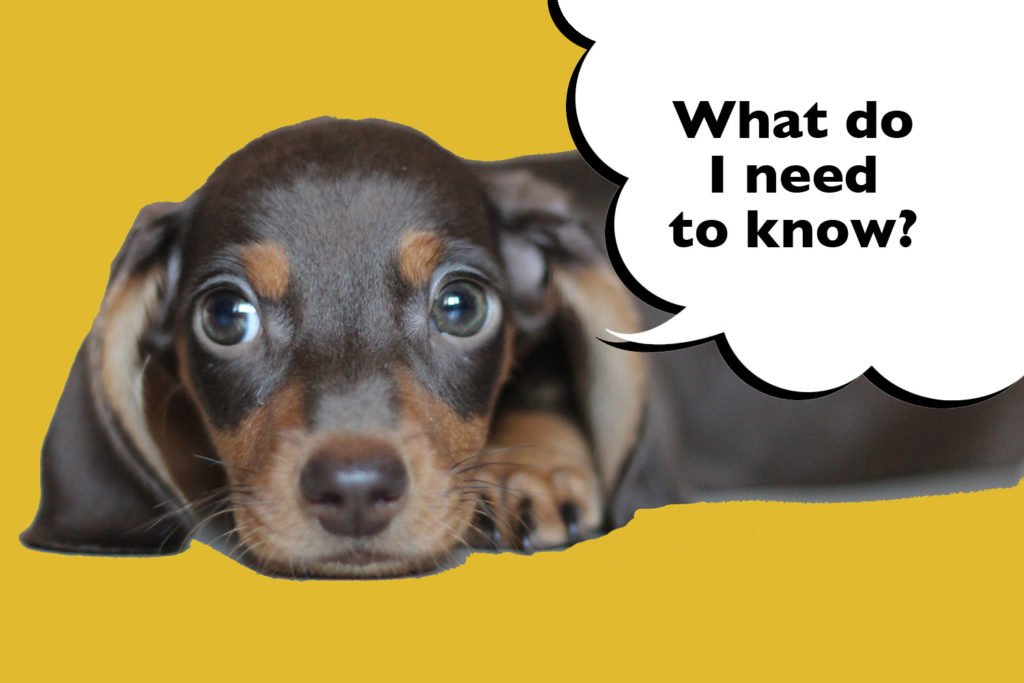
8. How Their Walking Equipment Feels
The 8th thing you need to teach your Dachshund puppy is how their walking equipment feels to wear.
Many owners prefer to use a harness for their Dachshund. This is to try and reduce the risk of causing them any damage to their delicate neck or spine if they pull on the leash.
However, it’s a good idea to get your puppy used to wearing both a collar and a harness. Just in case you ever need to change from using one to the other.
It’s down to you to decide which option is best for your Dachshund. But no matter which option you choose, it’s important that your Dachshund gets used to wearing it from an early age.
You should introduce the collar and/or harness carefully and slowly, to make sure not to cause your puppy any stress.
It’s vital that they fit your Dachshund well too, so they’re comfortable and not restricted when they’re walking.
The same is true of any jumpers or coats that your Dachshund wears too. They shouldn’t restrict or limit their movements in any way.
If your Dachshund shows any sign of distress when they’re wearing a collar, harness, jumper or coat, you should remove it and slowly reintroduce it at another time.
Click here to find out the pros and cons of both collars and harnesses
9. How To Walk On A Leash
Once your Dachshund puppy has been carefully introduced to their collar or harness, the 9th thing you need to teach them is how to walk properly on a leash.
To begin with, your puppy may find it strange to feel the weight or pressure of a lead being attached to them. They’ve never experienced the feeling of being restricted in this way before.
However, this is a vital lesson for you to teach your Dachshund puppy, to enable them to get out on walks and safely explore the outside world.
You can prepare your Dachshund puppy for walks long before they’ve had their jabs, by getting them used to being walked on a leash in your own home first.
Just be sure to limit any training to just a few minutes at first.
There are loads of different kinds of leashes available on the market, each with their own advantages and disadvantages. It’s up to you to find the one most suitable for your own Dachshund.
So long as they’re secure, not too heavy and comfortable for your Dachshund to wear, then you’re on the right path.
By making sure that your Dachshund is fully comfortable and confident whilst wearing their leash, you’re setting them up for success when they’re allowed outside on adventures.
Click here to find out how to teach your Dachshund puppy to walk on a leash!
10. To Come To You When Called
The 10th thing you need to teach your Dachshund puppy is to come to you when called.
Teaching your Dachshund a recall is just the official way of saying to teach them to come back to you when they’re called.
This is an absolutely essential thing for you to teach your Dachshund. Not only does this allow them more freedom, but it also helps to keep your Dachshund safe.
You can start teaching your Dachshund a recall a short while after you bring them home. Just don’t confuse this with their name training as you want to nail that before you do anything else.
In fact, it’s sometimes best to avoid using their name for recall and simply choose a command specifically for recall like ‘Come’ or ‘Here,’ so long as this is consistently used.
Click here to find out how to teach your Dachshund puppy to come when called!
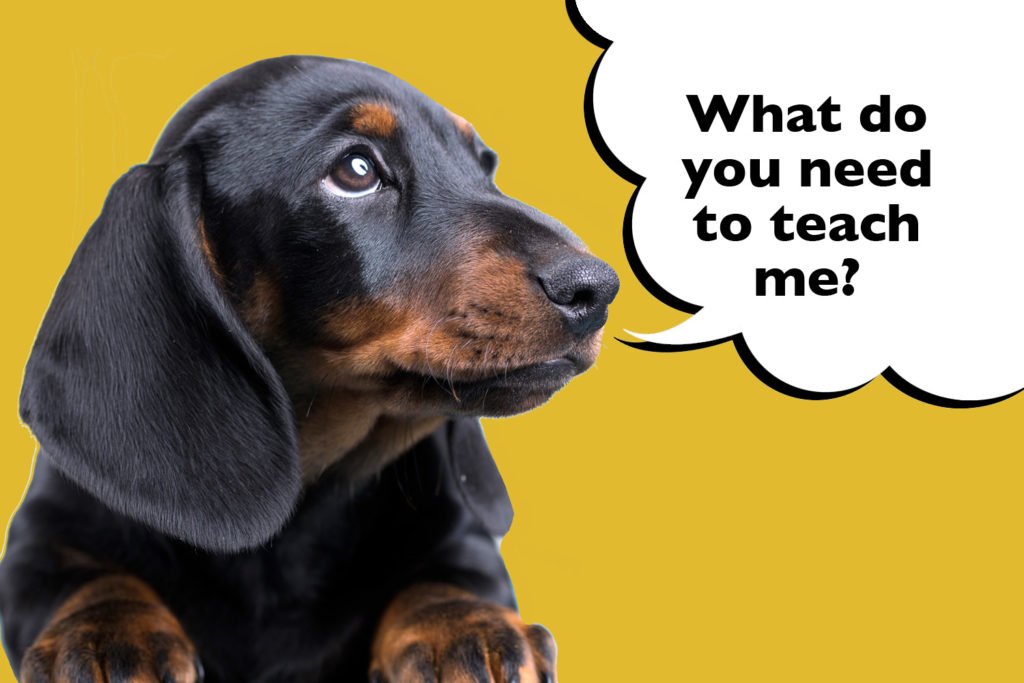
11. How To Use A Dog Ramp
The 11th thing you need to teach your Dachshund puppy is how to use a dog ramp. This is a great thing to teach from an early age.
Not only will this hopefully prevent your Dachshund from injuring their fragile spines and limbs whilst they’re younger, it’ll also help them out as they get older when they’re not as agile and flexible as they used to be.
It’s best to introduce the ramp to your Dachshund as a puppy, so they’re already comfortable using one should they need to.
Many Dachshunds enjoy spending time snuggled on the sofa or bed with their owners. But allowing them to jump on and off high places like these can leave them open to back injuries.
The same applies to letting them jump in and out of the car and even letting them go up and down steep stairs and steps.
These kinds of repetitive movements may contribute to spinal injuries like Intervertebral Disc Disease (IVDD) and other issues developing.
By getting your Dachshund used to using a ramp in these situations, the risk of them injuring themselves is drastically reduced.
Click here to find out how to train your Dachshund puppy to use a dog ramp!
Click here to find out how to reduce the risk of IVDD
12. Dog Training Is Fun
The 12th thing you need to teach your Dachshund puppy is that dog training is fun, so that they want to do more of it.
And the best and most effective way of doing that is through Positive Reinforcement.
With this method, you reward your Dachshund for showing behaviours that are desirable to you and simply ignore the behaviours you wish to see less of.
This is not only the kindest method for training your Dachshund, but also the fastest.
Because your Dachshund is receiving a high value reward and praise for demonstrating a behaviour, they’re much more likely to do it again in order to receive another reward.
Positive Reinforcement training sets your Dachshund up for success and rewards them for doing so. Instead of waiting for them to fail and punishing them for mistakes.
By punishing your Dachshund, it’s likely to make them feel more scared of you. It certainly won’t help them to behave in a better way. In fact, it can often make behavioural issues worse.
It’s your job to teach your Dachshund how to behave as this is something they don’t have a ready-made understanding of.
Click here to find out how to discipline your Dachshund puppy using Positive Reinforcement
So, that’s the long and the short of it! There’s no doubt that choosing to bring a Dachshund puppy into your life is one of the most exciting decisions you’ll ever make, but it can also feel very overwhelming. Your new puppy comes to you needing to learn everything about the world, and it’s your job to teach them. But, that’s what this blog is all about and why it was created – to help Dachshund owners just like YOU to get the answers you need!
What do I do next?
If you read all the way to the end of this article, you’re exactly the sort of person I’d LOVE to join my Facebook Group. Your support for my blog means everything to me so, if you found this article helpful, please kindly share below. Thank you! 💋


